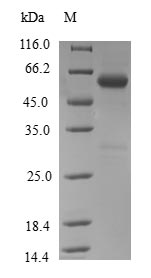Recombinant human tRNA N6-adenosine threonylcarbamoyltransferase (OSGEP) production in E. coli involves cloning the target gene tagged with an N-terminal GST gene into an expression vector and transforming it into E. coli cells. The target gene encodes the full-length human OSGEP (1-335aa). These cells are cultured under conditions that induce protein expression. After sufficient growth is achieved, the cells are lysed to release the recombinant OSGEP protein, which is subjected to affinity chromatography purification. The purity of the OSGEP protein is confirmed using SDS-PAGE, exceeding 90%.
Human OSGEP is a crucial component of the KEOPS complex involved in the biosynthesis of N6-threonylcarbamoyladenosine (t6A) modification on tRNAs. This modification, occurring at position 37 of tRNAs that recognize codons starting with adenosine (ANN codons), is essential for translational accuracy and efficiency across all branches of life [1][2][3]. The KEOPS complex, comprising OSGEP among other proteins, cooperates with Sua5/YRDC to catalyze the biosynthesis of tRNA N6-threonylcarbamoyladenosine, a modification vital for cellular fitness [4][5]. Furthermore, OSGEP, belonging to the YgjD/Kae1/OSGEP protein family, plays a crucial role in the biosynthesis of t6A at position 37 of tRNAs, ensuring accurate translation of messenger RNAs [6][7].
Studies have shown that defects in t6A tRNA modification, as mediated by OSGEP and associated proteins, can lead to conditions like Galloway-Mowat syndrome, underscoring the significance of this modification for normal cellular function [3][7]. Additionally, the KEOPS complex, including OSGEP, has been implicated in promoting homologous recombination via DNA resection, indicating its multifaceted roles in cellular processes beyond tRNA modification [8].
References:
[1] C. Su, M. Jin, & W. Zhang, Conservation and diversification of trna t6a-modifying enzymes across the three domains of life, International Journal of Molecular Sciences, vol. 23, no. 21, p. 13600, 2022. https://doi.org/10.3390/ijms232113600
[2] L. Wan, M. Pillon, N. Thevakumaran, Y. Sun, A. Chakrabartty, A. Guarnéet al., Structural and functional characterization of keops dimerization by pcc1 and its role in t6a biosynthesis, Nucleic Acids Research, vol. 44, no. 14, p. 6971-6980, 2016. https://doi.org/10.1093/nar/gkw542
[3] C. Arrondel, S. Missoury, R. Snoek, J. Patat, G. Menara, B. Collinetet al., Defects in t6a trna modification due to gon7 and yrdc mutations lead to galloway-mowat syndrome, Nature Communications, vol. 10, no. 1, 2019. https://doi.org/10.1038/s41467-019-11951-x
[4] X. Zheng, Molecular basis of a. thaliana keops complex in biosynthesizing trna t6a, Nucleic Acids Research, vol. 52, no. 8, p. 4523-4540, 2024. https://doi.org/10.1093/nar/gkae179
[5] L. Wan, P. Maisonneuve, R. Szilard, J. Lambert, T. Ng, N. Manczyket al., Proteomic analysis of the human keops complex identifies c14orf142 as a core subunit homologous to yeast gon7, Nucleic Acids Research, vol. 45, no. 2, p. 805-817, 2016. https://doi.org/10.1093/nar/gkw1181
[6] A. Costessi, N. Mahrour, V. Sharma, R. Stunnenberg, M. Stoel, E. Tijchonet al., The human ekc/keops complex is recruited to cullin2 ubiquitin ligases by the human tumour antigen prame, Plos One, vol. 7, no. 8, p. e42822, 2012. https://doi.org/10.1371/journal.pone.0042822
[7] H. Hyun, S. Kim, E. Park, M. Cho, H. Kang, H. Leeet al., A familial case of galloway-mowat syndrome due to a novel tp53rk mutation: a case report, BMC Medical Genetics, vol. 19, no. 1, 2018. https://doi.org/10.1186/s12881-018-0649-y
[8] M. He, J. Liu, Y. Lu, Z. Wu, Y. Liu, Z. Wuet al., Keops complex promotes homologous recombination via dna resection, Nucleic Acids Research, vol. 47, no. 11, p. 5684-5697, 2019. https://doi.org/10.1093/nar/gkz228






